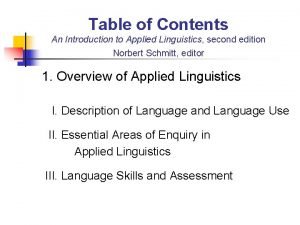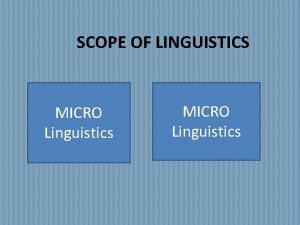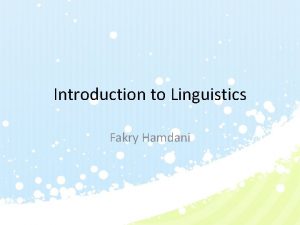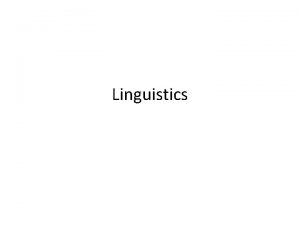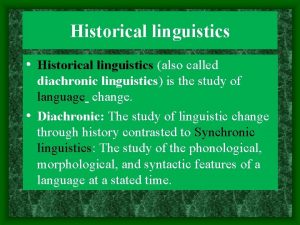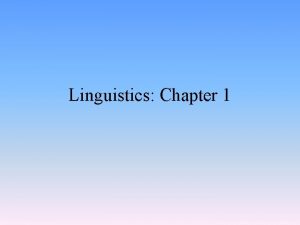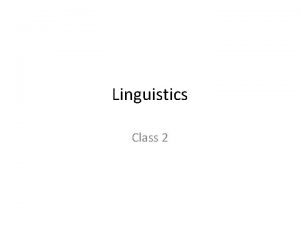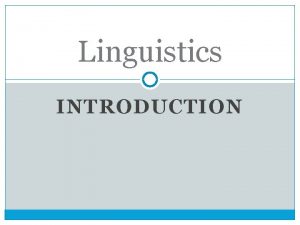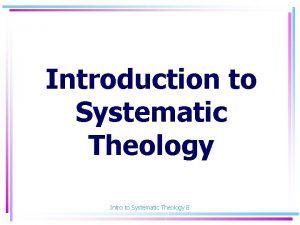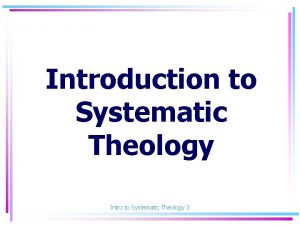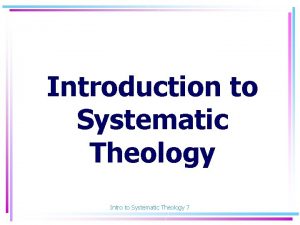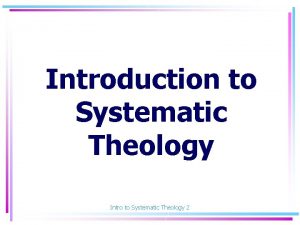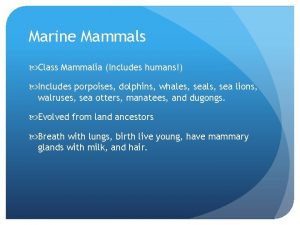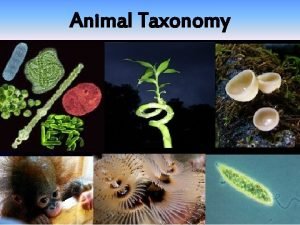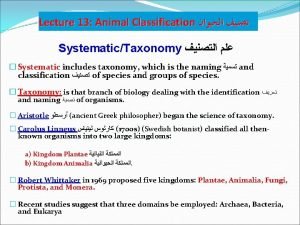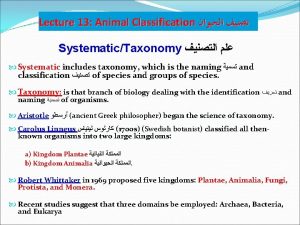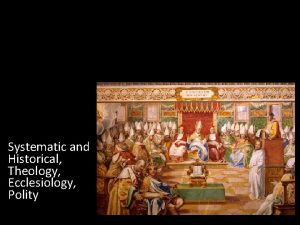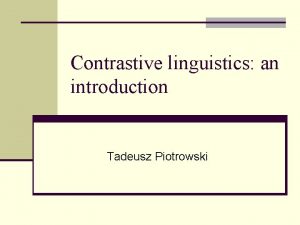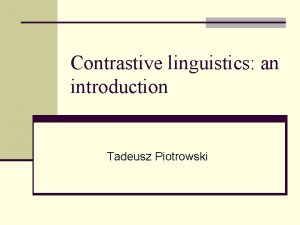Introduction to linguistics Linguistics includes the systematic and


























- Slides: 26



Introduction to linguistics • • • Linguistics includes the systematic and scientific study of language. Linguistics is concerned with understanding the structure and nature of language which is divided into: phonetics, phonology, morphology, syntax, semantics and pragmatics. Linguistics deals with other perspectives on language which are represented in specialized or interdisciplinary branches such as sociolinguistics, psycholinguistics, neurolinguistics and second language acquisition. ﻋﻤﺎﺩﺓ ﺍﻟﺘﻌﻠﻢ ﺍﻹﻟﻜﺘﺮﻭﻧﻲ ﻭﺍﻟﺘﻌﻠﻴﻢ ﻋﻦ ﺑﻌﺪ Deanship of E-Learning and Distance Education [ ] All Rights Reserved for KFU © ﺟﻤﻴﻊ ﺍﻟﺤﻘﻮﻕ ﻣﺤﻔﻮﻇﺔ ﻟﺠﺎﻣﻌﺔ ﺍﻟﻤﻠﻚ ﻓﻴﺼﻞ

Before we start: we should be aware that: • We do not know how language was originated. Yet, we know that spoken language developed thousand years before written language. • It is estimated that some spoken languages have developed between 100, 000 and 50, 000 years ago. • Written languages have developed nearly 5000 years ago. ﻋﻤﺎﺩﺓ ﺍﻟﺘﻌﻠﻢ ﺍﻹﻟﻜﺘﺮﻭﻧﻲ ﻭﺍﻟﺘﻌﻠﻴﻢ ﻋﻦ ﺑﻌﺪ Deanship of E-Learning and Distance Education [ ] All Rights Reserved for KFU © ﺟﻤﻴﻊ ﺍﻟﺤﻘﻮﻕ ﻣﺤﻔﻮﻇﺔ ﻟﺠﺎﻣﻌﺔ ﺍﻟﻤﻠﻚ ﻓﻴﺼﻞ

Before we start: we should be aware that: • There is ability of producing sounds and vocal patterning which is shared among different creatures such as fish and birds; but that is not human language. • No physical evidence relating to the speech of our distant ancestors that might tell us how language was existed in the early stages. ﻋﻤﺎﺩﺓ ﺍﻟﺘﻌﻠﻢ ﺍﻹﻟﻜﺘﺮﻭﻧﻲ ﻭﺍﻟﺘﻌﻠﻴﻢ ﻋﻦ ﺑﻌﺪ Deanship of E-Learning and Distance Education [ ] All Rights Reserved for KFU © ﺟﻤﻴﻊ ﺍﻟﺤﻘﻮﻕ ﻣﺤﻔﻮﻇﺔ ﻟﺠﺎﻣﻌﺔ ﺍﻟﻤﻠﻚ ﻓﻴﺼﻞ

Speculations about the sources of the origins of language 1. The divine source 2. The natural sound source (bow-wow/pooh-pooh theories) 3. The social interaction source 4. The physical adaptation source (teeth and lips/mouth and tongue and larynx and pharynx) 5. The tool-making source (the human brain) 6. The genetic source (innateness hypothesis) ﻋﻤﺎﺩﺓ ﺍﻟﺘﻌﻠﻢ ﺍﻹﻟﻜﺘﺮﻭﻧﻲ ﻭﺍﻟﺘﻌﻠﻴﻢ ﻋﻦ ﺑﻌﺪ Deanship of E-Learning and Distance Education [ ] All Rights Reserved for KFU © ﺟﻤﻴﻊ ﺍﻟﺤﻘﻮﻕ ﻣﺤﻔﻮﻇﺔ ﻟﺠﺎﻣﻌﺔ ﺍﻟﻤﻠﻚ ﻓﻴﺼﻞ

1. The divine source • Divine is related to God or Creator ‘ ’ﺍﻟﻬﻲ. • In most religions, it is believed that language appears to be a divine source that provides human with language. • Some experiments confirm that if human infant get deprived of hearing language around them, they would spontaneously begin using God or Creator-given language in the Psamtik story. ﻋﻤﺎﺩﺓ ﺍﻟﺘﻌﻠﻢ ﺍﻹﻟﻜﺘﺮﻭﻧﻲ ﻭﺍﻟﺘﻌﻠﻴﻢ ﻋﻦ ﺑﻌﺪ Deanship of E-Learning and Distance Education [ ] All Rights Reserved for KFU © ﺟﻤﻴﻊ ﺍﻟﺤﻘﻮﻕ ﻣﺤﻔﻮﻇﺔ ﻟﺠﺎﻣﻌﺔ ﺍﻟﻤﻠﻚ ﻓﻴﺼﻞ

1. The divine source • Yet, other experiments - of children who lived in isolation without contact with humans - did not confirm the results of divine-source experiments as in the Cases of Victor and Aveyron who were discovered in the 18 th century; as they did not show a spontaneous language, as in the previous experiment. ﻋﻤﺎﺩﺓ ﺍﻟﺘﻌﻠﻢ ﺍﻹﻟﻜﺘﺮﻭﻧﻲ ﻭﺍﻟﺘﻌﻠﻴﻢ ﻋﻦ ﺑﻌﺪ Deanship of E-Learning and Distance Education [ ] All Rights Reserved for KFU © ﺟﻤﻴﻊ ﺍﻟﺤﻘﻮﻕ ﻣﺤﻔﻮﻇﺔ ﻟﺠﺎﻣﻌﺔ ﺍﻟﻤﻠﻚ ﻓﻴﺼﻞ

2. The natural sound source • This view is based on the concept that natural sounds which are attained through the auditory system that develops before birth which later develop to identify sounds in the environment. • This will help humans to connect between a sound and the thing (or organ) producing that sound. • Imitation of natural sounds lead to the development of primitive words (which were heard by early men and women around them). • Jespersen (1922) called this idea of acquiring natural sounds ‘Bow-wow’ and ‘Pooh-pooh’ theories. ﻋﻤﺎﺩﺓ ﺍﻟﺘﻌﻠﻢ ﺍﻹﻟﻜﺘﺮﻭﻧﻲ ﻭﺍﻟﺘﻌﻠﻴﻢ ﻋﻦ ﺑﻌﺪ Deanship of E-Learning and Distance Education [ ] All Rights Reserved for KFU © ﺟﻤﻴﻊ ﺍﻟﺤﻘﻮﻕ ﻣﺤﻔﻮﻇﺔ ﻟﺠﺎﻣﻌﺔ ﺍﻟﻤﻠﻚ ﻓﻴﺼﻞ

Bow-wow theory • It focuses on imitation of sounds then using it to refer to objects (even when they are not present), e. g. Coo-Coo. • In every language, there are words which seem to be naturally occurring sounds such as splash and boom; which may refer to sounds similar to the noises they describe. • Yet, it is hard to see how soundless things (low branch) or abstract concepts (truth) have been referred to in a language that echoed natural sounds. Therefore, the view that language is only a set of words to describe names for things not always necessary. ﻋﻤﺎﺩﺓ ﺍﻟﺘﻌﻠﻢ ﺍﻹﻟﻜﺘﺮﻭﻧﻲ ﻭﺍﻟﺘﻌﻠﻴﻢ ﻋﻦ ﺑﻌﺪ Deanship of E-Learning and Distance Education [ ] All Rights Reserved for KFU © ﺟﻤﻴﻊ ﺍﻟﺤﻘﻮﻕ ﻣﺤﻔﻮﻇﺔ ﻟﺠﺎﻣﻌﺔ ﺍﻟﻤﻠﻚ ﻓﻴﺼﻞ

Pooh-pooh theory • While this theory is based on that speech developed from the instinctive sounds people make in emotional circumstances. • So, the original sound of language came from natural cries of emotion such as pain, anger or joy. • Words such as Ah!, Wow!, Ooh! are all used with sudden intakes of breath; unlike when we want to talk which is the opposite. ﻋﻤﺎﺩﺓ ﺍﻟﺘﻌﻠﻢ ﺍﻹﻟﻜﺘﺮﻭﻧﻲ ﻭﺍﻟﺘﻌﻠﻴﻢ ﻋﻦ ﺑﻌﺪ Deanship of E-Learning and Distance Education [ ] All Rights Reserved for KFU © ﺟﻤﻴﻊ ﺍﻟﺤﻘﻮﻕ ﻣﺤﻔﻮﻇﺔ ﻟﺠﺎﻣﻌﺔ ﺍﻟﻤﻠﻚ ﻓﻴﺼﻞ

3. The social interaction source • • This view is based on the idea that the source of our language is the physical effort of several people and interaction which is to be coordinated. It happens when a group of early humans develop a set of hums, groans … etc. that were used when they were carrying things. It claims that the development of human language takes place in a social context through groups. Groups are important particularly in the past to main communication; which had different uses within their social interaction. ﻋﻤﺎﺩﺓ ﺍﻟﺘﻌﻠﻢ ﺍﻹﻟﻜﺘﺮﻭﻧﻲ ﻭﺍﻟﺘﻌﻠﻴﻢ ﻋﻦ ﺑﻌﺪ Deanship of E-Learning and Distance Education [ ] All Rights Reserved for KFU © ﺟﻤﻴﻊ ﺍﻟﺤﻘﻮﻕ ﻣﺤﻔﻮﻇﺔ ﻟﺠﺎﻣﻌﺔ ﺍﻟﻤﻠﻚ ﻓﻴﺼﻞ

4. The physical adaptation source • This source is based on physical features human processes that are distinct from other creatures (particularly non-humans) which may have enabled speech production. • Our (human) ancestors showed adaptation to upright posture and revised role for the front limbs. • Adaptation (or changed) happened to fossilized skeletal structures which later began to be similar to modern humans. ﻋﻤﺎﺩﺓ ﺍﻟﺘﻌﻠﻢ ﺍﻹﻟﻜﺘﺮﻭﻧﻲ ﻭﺍﻟﺘﻌﻠﻴﻢ ﻋﻦ ﺑﻌﺪ Deanship of E-Learning and Distance Education [ ] All Rights Reserved for KFU © ﺟﻤﻴﻊ ﺍﻟﺤﻘﻮﻕ ﻣﺤﻔﻮﻇﺔ ﻟﺠﺎﻣﻌﺔ ﺍﻟﻤﻠﻚ ﻓﻴﺼﻞ

4. The physical adaptation source • This (partial) adaptation appeared to be more relevant to speech. • Such features would not enable speech in some primates; yet they are clues that a creature with similar features might have the capacity for speech production. ﻋﻤﺎﺩﺓ ﺍﻟﺘﻌﻠﻢ ﺍﻹﻟﻜﺘﺮﻭﻧﻲ ﻭﺍﻟﺘﻌﻠﻴﻢ ﻋﻦ ﺑﻌﺪ Deanship of E-Learning and Distance Education [ ] All Rights Reserved for KFU © ﺟﻤﻴﻊ ﺍﻟﺤﻘﻮﻕ ﻣﺤﻔﻮﻇﺔ ﻟﺠﺎﻣﻌﺔ ﺍﻟﻤﻠﻚ ﻓﻴﺼﻞ

Teeth and lips • Human teeth are different from other creatures. They are suitable to produce sounds such as F or V. • Human teeth are upright and suitable for chewing. • Human lips have intricate muscle interlacing more than other primates. • Human lips are appropriate to produce sounds such as P or B and M. ﻋﻤﺎﺩﺓ ﺍﻟﺘﻌﻠﻢ ﺍﻹﻟﻜﺘﺮﻭﻧﻲ ﻭﺍﻟﺘﻌﻠﻴﻢ ﻋﻦ ﺑﻌﺪ Deanship of E-Learning and Distance Education [ ] All Rights Reserved for KFU © ﺟﻤﻴﻊ ﺍﻟﺤﻘﻮﻕ ﻣﺤﻔﻮﻇﺔ ﻟﺠﺎﻣﻌﺔ ﺍﻟﻤﻠﻚ ﻓﻴﺼﻞ

Mouth and tongue • Human mouth are small compared to other creatures; as a part of an extended vocal tract with an L-shape not straight path from front to back. • Human tongue are shorter, thicker and more muscular than other creatures; to produce a variety od sounds inside the oral cavity. • The intricate muscles in mouth and tongue and lips and teeth help to articulate a wider range of shapes and a more powerful delivery of sounds produced through these shapes. ﻋﻤﺎﺩﺓ ﺍﻟﺘﻌﻠﻢ ﺍﻹﻟﻜﺘﺮﻭﻧﻲ ﻭﺍﻟﺘﻌﻠﻴﻢ ﻋﻦ ﺑﻌﺪ Deanship of E-Learning and Distance Education [ ] All Rights Reserved for KFU © ﺟﻤﻴﻊ ﺍﻟﺤﻘﻮﻕ ﻣﺤﻔﻮﻇﺔ ﻟﺠﺎﻣﻌﺔ ﺍﻟﻤﻠﻚ ﻓﻴﺼﻞ

Larynx and pharynx • Human larynx is ‘voice box’ which comprises of vocal folds and vocal cords; which different other creatures larynx. • Larynx helps human to choke on pieces of food. • Human pharynx has a longer cavity than many other creatures; which works as a resonator for increased range and clarity of the sounds produced through the larynx and vocal tract. ﻋﻤﺎﺩﺓ ﺍﻟﺘﻌﻠﻢ ﺍﻹﻟﻜﺘﺮﻭﻧﻲ ﻭﺍﻟﺘﻌﻠﻴﻢ ﻋﻦ ﺑﻌﺪ Deanship of E-Learning and Distance Education [ ] All Rights Reserved for KFU © ﺟﻤﻴﻊ ﺍﻟﺤﻘﻮﻕ ﻣﺤﻔﻮﻇﺔ ﻟﺠﺎﻣﻌﺔ ﺍﻟﻤﻠﻚ ﻓﻴﺼﻞ

Larynx and pharynx • Therefore, there advantages of getting this extra vocal power to outweigh the potential disadvantages from an increased risk of chocking which might lead to death. ﻋﻤﺎﺩﺓ ﺍﻟﺘﻌﻠﻢ ﺍﻹﻟﻜﺘﺮﻭﻧﻲ ﻭﺍﻟﺘﻌﻠﻴﻢ ﻋﻦ ﺑﻌﺪ Deanship of E-Learning and Distance Education [ ] All Rights Reserved for KFU © ﺟﻤﻴﻊ ﺍﻟﺤﻘﻮﻕ ﻣﺤﻔﻮﻇﺔ ﻟﺠﺎﻣﻌﺔ ﺍﻟﻤﻠﻚ ﻓﻴﺼﻞ

5. The tool-making source • It is speculated that human hands and manual gestures may have been a precursor of language. • Two million years ago, human managed to develop preferential right-handedness and had become able to make stone tools; tool-making is evidence of a brain at work. ﻋﻤﺎﺩﺓ ﺍﻟﺘﻌﻠﻢ ﺍﻹﻟﻜﺘﺮﻭﻧﻲ ﻭﺍﻟﺘﻌﻠﻴﻢ ﻋﻦ ﺑﻌﺪ Deanship of E-Learning and Distance Education [ ] All Rights Reserved for KFU © ﺟﻤﻴﻊ ﺍﻟﺤﻘﻮﻕ ﻣﺤﻔﻮﻇﺔ ﻟﺠﺎﻣﻌﺔ ﺍﻟﻤﻠﻚ ﻓﻴﺼﻞ

The human brain (1) • The human brain is lateralized; where it has different functions for each hemisphere. • Left hemisphere of the brain is responsible for complex vocalization and speaking • Interestingly, motor cortex that controls the muscles of the arms and hands is next to articulatory muscles of face and jaw. It is believed that there is a connection between the language-using and toolusing abilities of humans. ﻋﻤﺎﺩﺓ ﺍﻟﺘﻌﻠﻢ ﺍﻹﻟﻜﺘﺮﻭﻧﻲ ﻭﺍﻟﺘﻌﻠﻴﻢ ﻋﻦ ﺑﻌﺪ Deanship of E-Learning and Distance Education [ ] All Rights Reserved for KFU © ﺟﻤﻴﻊ ﺍﻟﺤﻘﻮﻕ ﻣﺤﻔﻮﻇﺔ ﻟﺠﺎﻣﻌﺔ ﺍﻟﻤﻠﻚ ﻓﻴﺼﻞ

The human brain (2) • Many speculative proposals argue that the origins of speech is based on human producing single noises to indicate objects in their environment. Yet, it lacks structural organization. All languages require the organizing and combining of sounds and signs in specific arrangement. ﻋﻤﺎﺩﺓ ﺍﻟﺘﻌﻠﻢ ﺍﻹﻟﻜﺘﺮﻭﻧﻲ ﻭﺍﻟﺘﻌﻠﻴﻢ ﻋﻦ ﺑﻌﺪ Deanship of E-Learning and Distance Education [ ] All Rights Reserved for KFU © ﺟﻤﻴﻊ ﺍﻟﺤﻘﻮﻕ ﻣﺤﻔﻮﻇﺔ ﻟﺠﺎﻣﻌﺔ ﺍﻟﻤﻠﻚ ﻓﻴﺼﻞ

The human brain (3) • In terms of tool-making, it is not enough for human to grasp one rock (to make one sound) but need to bring two rocks to create proper contact with the first and to develop a tool • In terms of language structure, the human may have developed the naming ability first for producing consistent noise; then to bring another specific noise to build a complex message. ﻋﻤﺎﺩﺓ ﺍﻟﺘﻌﻠﻢ ﺍﻹﻟﻜﺘﺮﻭﻧﻲ ﻭﺍﻟﺘﻌﻠﻴﻢ ﻋﻦ ﺑﻌﺪ Deanship of E-Learning and Distance Education [ ] All Rights Reserved for KFU © ﺟﻤﻴﻊ ﺍﻟﺤﻘﻮﻕ ﻣﺤﻔﻮﻇﺔ ﻟﺠﺎﻣﻌﺔ ﺍﻟﻤﻠﻚ ﻓﻴﺼﻞ

6. The genetic source (innateness hypothesis) • The human baby are born with larynx that is higher in the throat that is to breathe and drink at the same time. • After a few months, the larynx descends, the brain develops and start walking and talking. • In fact, young child’s language is complex and seen as more than physical adaption of species. It seems that language is an innate feature; what is known as ‘innateness hypothesis’ ﻋﻤﺎﺩﺓ ﺍﻟﺘﻌﻠﻢ ﺍﻹﻟﻜﺘﺮﻭﻧﻲ ﻭﺍﻟﺘﻌﻠﻴﻢ ﻋﻦ ﺑﻌﺪ Deanship of E-Learning and Distance Education [ ] All Rights Reserved for KFU © ﺟﻤﻴﻊ ﺍﻟﺤﻘﻮﻕ ﻣﺤﻔﻮﻇﺔ ﻟﺠﺎﻣﻌﺔ ﺍﻟﻤﻠﻚ ﻓﻴﺼﻞ

6. The genetic source (innateness hypothesis) • The ‘innateness hypothesis’ refers to something in human genetics as the source, possibly a crucial mutation. • As we consider this hypothesis, there is a movement from fossil evidence or the physical source of adaptation towards analogies with how computer work (being pre-programmed or hardwired) ﻋﻤﺎﺩﺓ ﺍﻟﺘﻌﻠﻢ ﺍﻹﻟﻜﺘﺮﻭﻧﻲ ﻭﺍﻟﺘﻌﻠﻴﻢ ﻋﻦ ﺑﻌﺪ Deanship of E-Learning and Distance Education [ ] All Rights Reserved for KFU © ﺟﻤﻴﻊ ﺍﻟﺤﻘﻮﻕ ﻣﺤﻔﻮﻇﺔ ﻟﺠﺎﻣﻌﺔ ﺍﻟﻤﻠﻚ ﻓﻴﺼﻞ

6. The genetic source (innateness hypothesis) • Yet, we are not sure when this rapidly genetic change might take place or how it might relate to the physical adaptation. ﻋﻤﺎﺩﺓ ﺍﻟﺘﻌﻠﻢ ﺍﻹﻟﻜﺘﺮﻭﻧﻲ ﻭﺍﻟﺘﻌﻠﻴﻢ ﻋﻦ ﺑﻌﺪ Deanship of E-Learning and Distance Education [ ] All Rights Reserved for KFU © ﺟﻤﻴﻊ ﺍﻟﺤﻘﻮﻕ ﻣﺤﻔﻮﻇﺔ ﻟﺠﺎﻣﻌﺔ ﺍﻟﻤﻠﻚ ﻓﻴﺼﻞ

 Traditional linguistics and modern linguistics
Traditional linguistics and modern linguistics Applied linguistics
Applied linguistics Introduction to language by george yule
Introduction to language by george yule Introducing phonetics and phonology answer key
Introducing phonetics and phonology answer key An introduction to applied linguistics
An introduction to applied linguistics Artificial language
Artificial language Hình ảnh bộ gõ cơ thể búng tay
Hình ảnh bộ gõ cơ thể búng tay Ng-html
Ng-html Bổ thể
Bổ thể Tỉ lệ cơ thể trẻ em
Tỉ lệ cơ thể trẻ em Voi kéo gỗ như thế nào
Voi kéo gỗ như thế nào Glasgow thang điểm
Glasgow thang điểm Bài hát chúa yêu trần thế alleluia
Bài hát chúa yêu trần thế alleluia Kể tên các môn thể thao
Kể tên các môn thể thao Thế nào là hệ số cao nhất
Thế nào là hệ số cao nhất Các châu lục và đại dương trên thế giới
Các châu lục và đại dương trên thế giới Công của trọng lực
Công của trọng lực Trời xanh đây là của chúng ta thể thơ
Trời xanh đây là của chúng ta thể thơ Mật thư tọa độ 5x5
Mật thư tọa độ 5x5 101012 bằng
101012 bằng độ dài liên kết
độ dài liên kết Các châu lục và đại dương trên thế giới
Các châu lục và đại dương trên thế giới Thơ thất ngôn tứ tuyệt đường luật
Thơ thất ngôn tứ tuyệt đường luật Quá trình desamine hóa có thể tạo ra
Quá trình desamine hóa có thể tạo ra Một số thể thơ truyền thống
Một số thể thơ truyền thống Cái miệng nó xinh thế
Cái miệng nó xinh thế Vẽ hình chiếu vuông góc của vật thể sau
Vẽ hình chiếu vuông góc của vật thể sau




